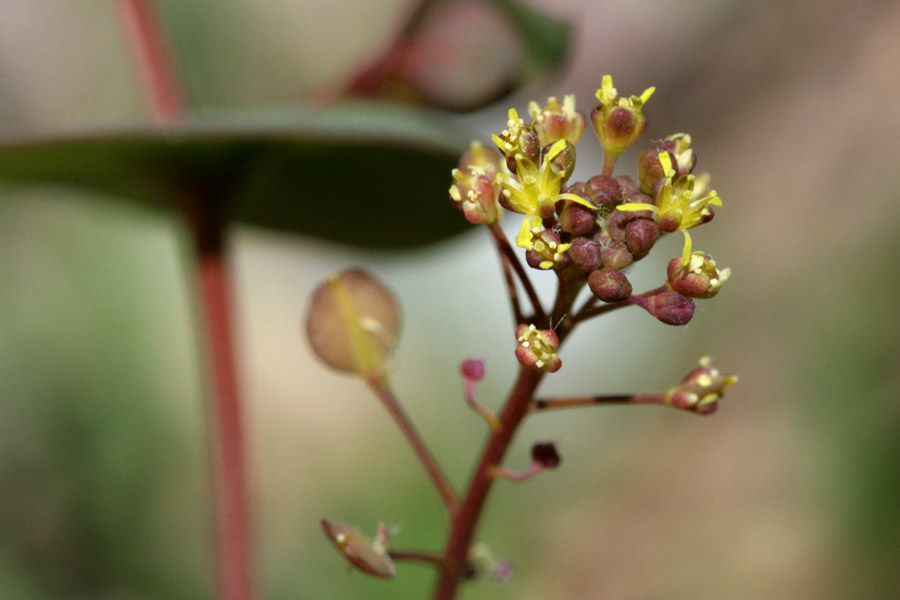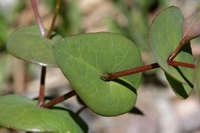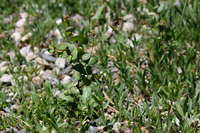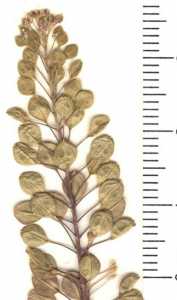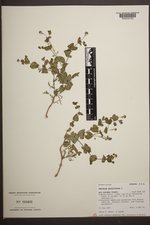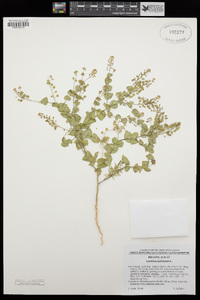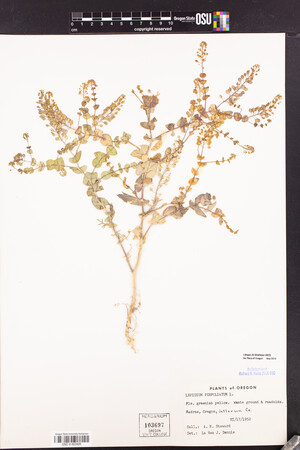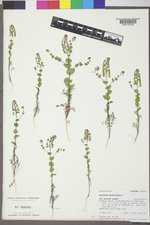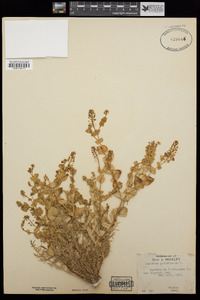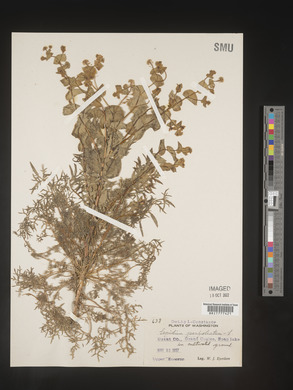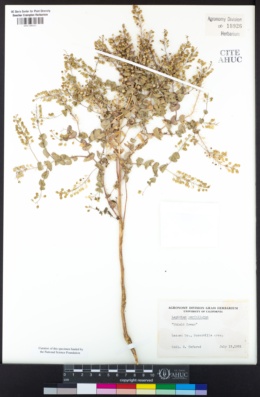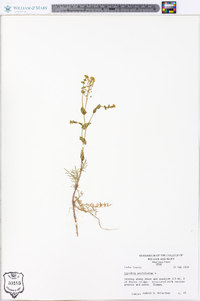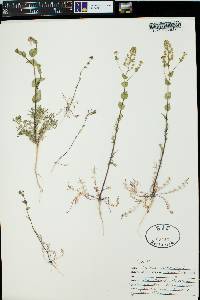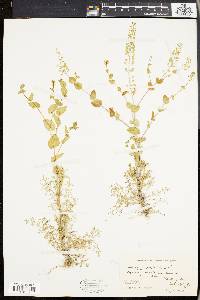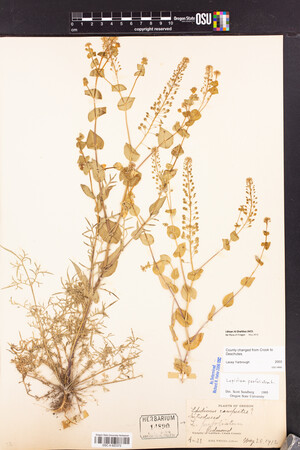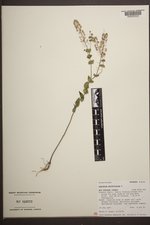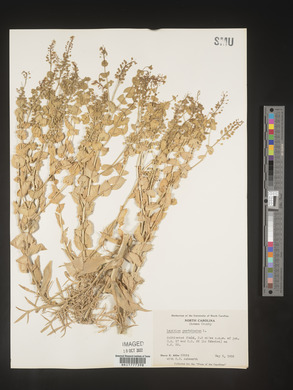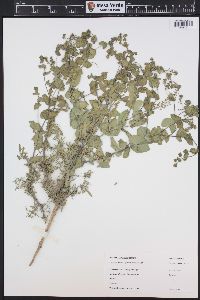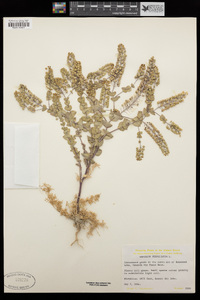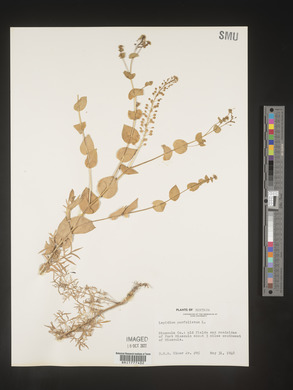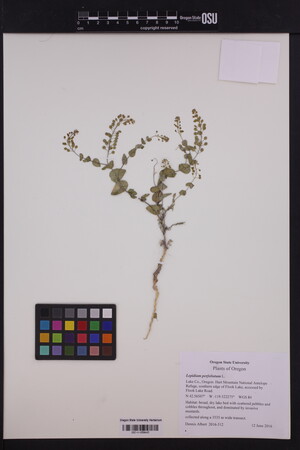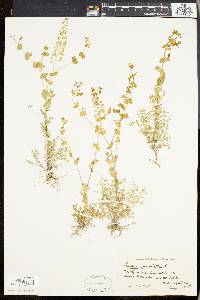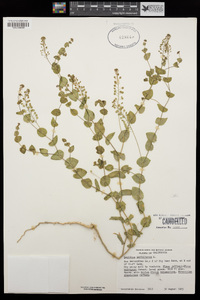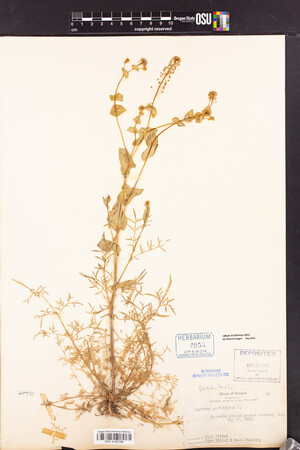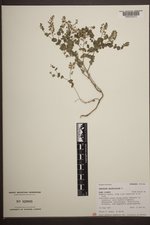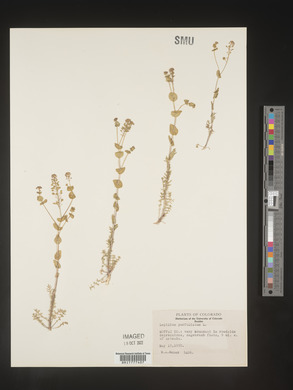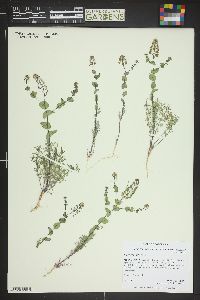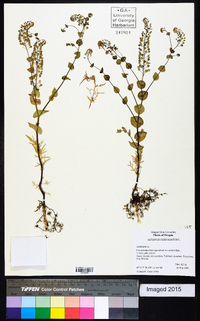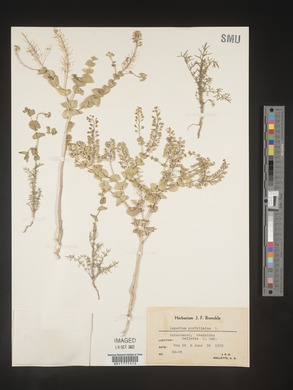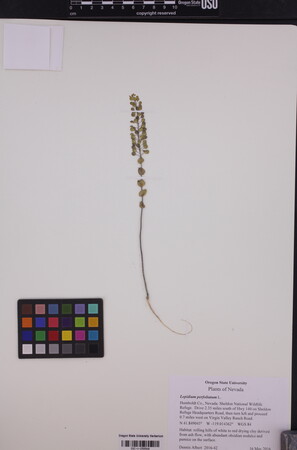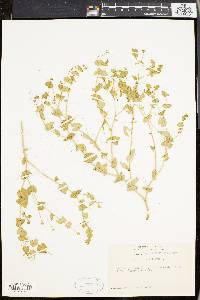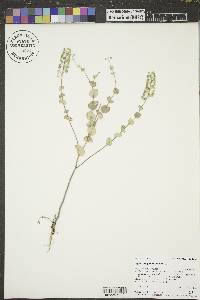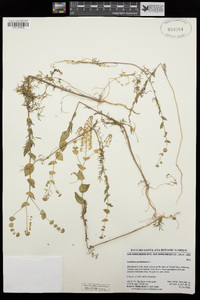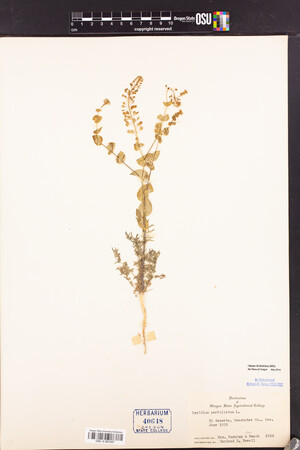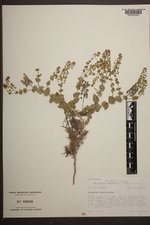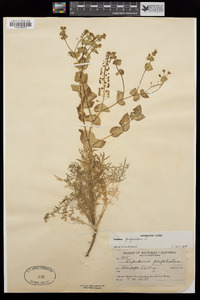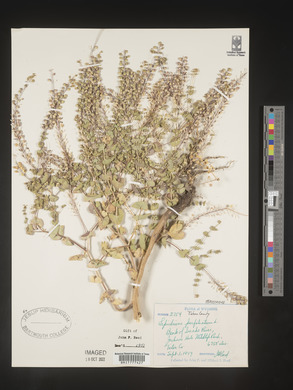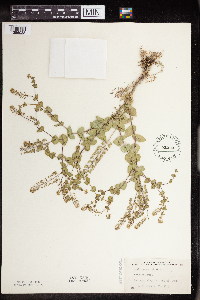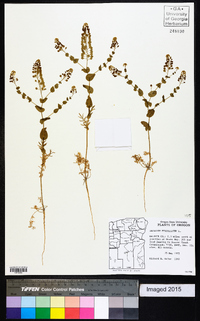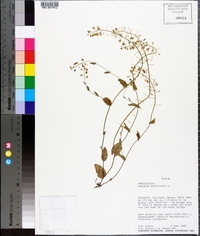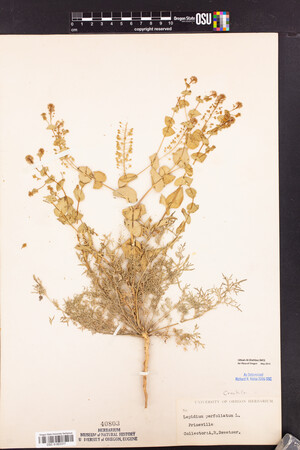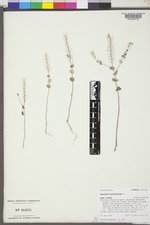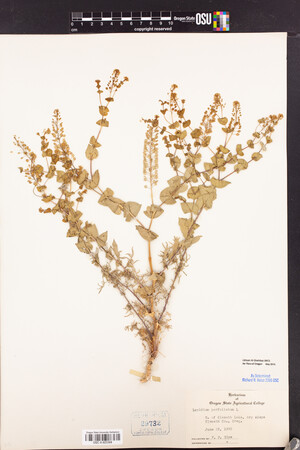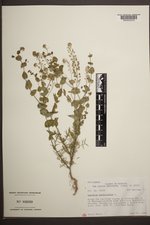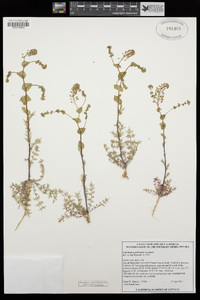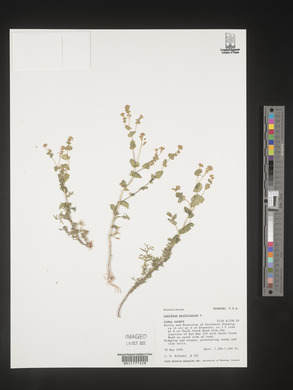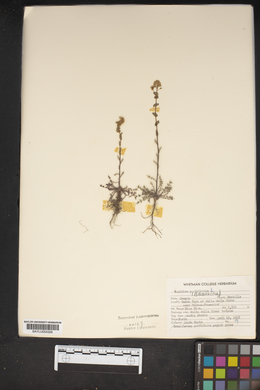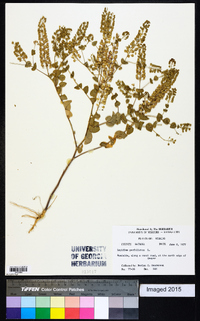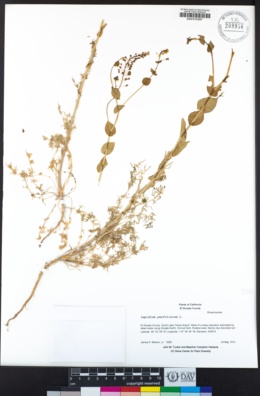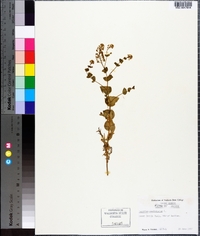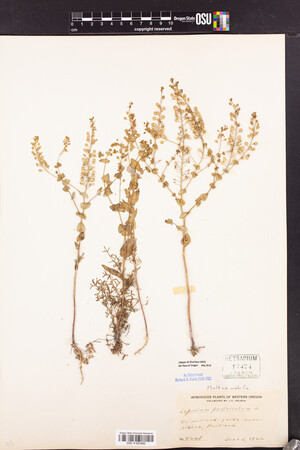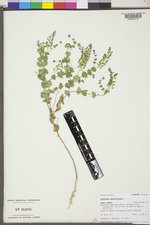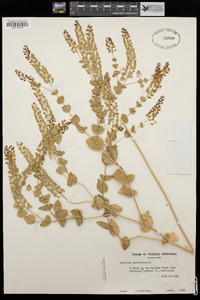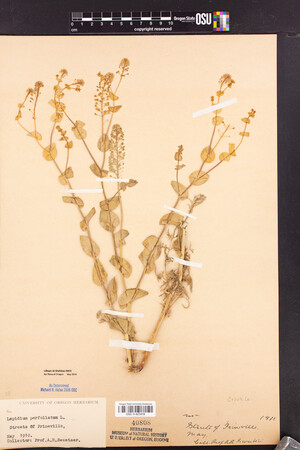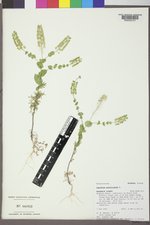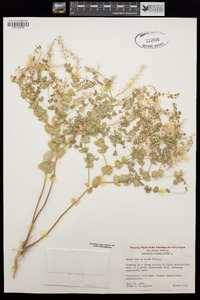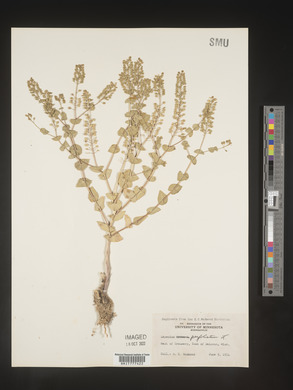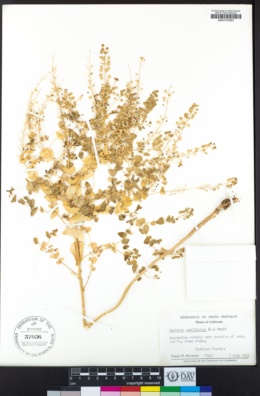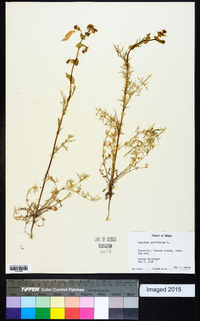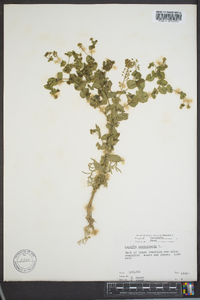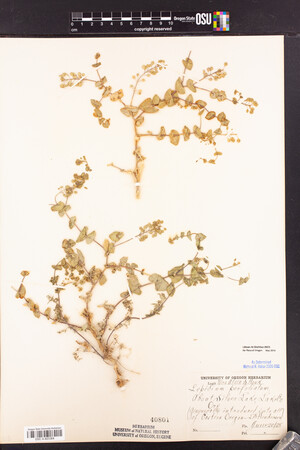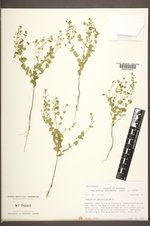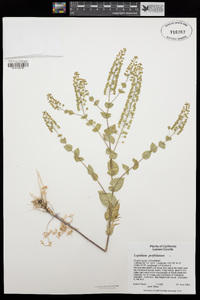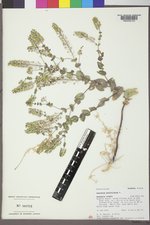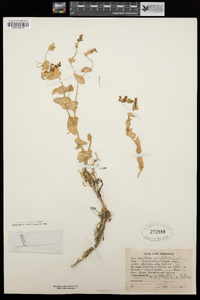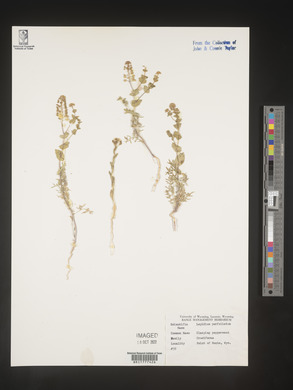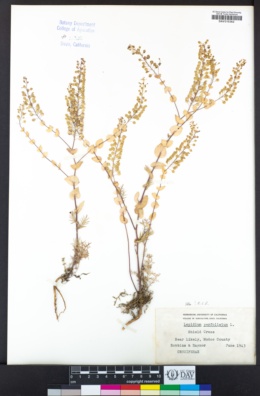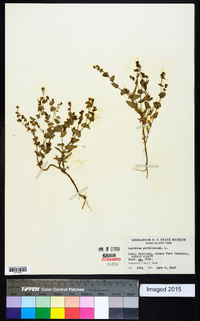Lepidium perfoliatum
|
|
|
|
Family: Brassicaceae
Clasping Pepperwort, more...clasping pepperweed, claspingleaf pepperweed
|
Annuals or biennials; (glaucous), glabrous or sparsely pubescent proximally. Stems simple from base, erect, branched distally, (0.7-)1.5-4.3(-5.6) dm. Basal leaves rosulate; petiole (0.5-) 1-2(-4) cm; blade 2- or 3-pinnatifid or pinnatisect (lobes linear to oblong), (1-)3-8(-15) cm, margins entire. Cauline leaves sessile; blade ovate to cordate or suborbicular, (0.5-)1-3 (-4) cm × (5-)10-25(-35) mm, base deeply cordate-amplexicaul, not auriculate, margins entire. Racemes considerably elongated in fruit; rachis glabrous. Fruiting pedicels divaricate-ascending to horizontal, straight, (terete), 3-6(-7) × 0.2-0.3 mm, glabrous. Flowers: sepals oblong, 0.8-1(-1.3) × 0.5-0.8 mm; petals pale yellow, narrowly spatulate, 1-1.5(-1.9) × 0.2-0.5 mm, claw 0.5-1 mm; stamens 6; filaments 0.6-0.9 mm, (glabrous); anthers 0.1-0.2 mm. Fruits orbicular to rhombic or broadly obovate, 3-4.5 (-5) × 3-4.1 mm, apically winged, apical notch 0.1-0.3 mm deep; valves thin, smooth, not or obscurely veined, glabrous; style 0.1-0.4 mm, subequaling or slightly exserted beyond apical notch. Seeds (dark brown), ovate, 1.6-2(-2.3) × 1.2-1.4 mm. 2n = 16. Flowering Mar-Jun. Waste places, dry sandy slopes, pinyon-juniper woodlands, sagebrush flats, open deserts, roadsides, pastures, meadows, open grasslands, alkaline flats and sinks, fields, disturbed sites; 0-2500 m; introduced; Alta., B.C., Man., Ont., Sask.; Ariz., Ark., Calif., Colo., Conn., Ga., Idaho, Ind., Iowa, Kans., Maine, Mass., Mich., Miss., Mo., Mont., Nebr., Nev., N.Mex., N.Y., N.C., Ohio, Okla., Oreg., Pa., S.Dak., Tenn., Utah, Wash., Wis., Wyo.; Europe; Asia; n Africa; introduced also in Mexico (Baja California), South America (Argentina), Australia. Annual herb 20 cm - 0.5 m tall Stem: upright, branched near the apex, sparsely hairy. Flowers: in branched clusters (raceme). Sepals four, 1 - 1.3 mm long, broadly oval, and firm. Petals four, yellow, 1 - 1.5 mm long, narrowly spatula-shaped. Stamens six. Fruit: a small pod, 4 mm long, 3 mm wide, diamond-shaped to elliptic, flattened, obscurely notched. Lower leaves: pinnately divided into linear segments, sparsely hairy. Upper leaves: alternate, clasping, stalkless, much shorter than lower leaves, heart-shaped, bases lobed, tips pointed, lobes long and usually overlapping, sparsely hairy. Similar species: Lepidium perfoliatum and Lepidium campestre are the only Lepidium species with lobed, clasping leaves. Lepidium campestre differs by being densely hairy all over. Flowering: late May to early June Habitat and ecology: Introduced from Europe. A weed found in disturbed areas, especially along roads and railroads. Occurence in the Chicago region: non-native Etymology: Lepidium comes from the Greek word lepis, meaning scale, which refers to the shape of the fruit. Perfoliatum means "with the leaf surrounding the stem." Author: The Morton Arboretum General: Introduced annual (sometimes biennial), 10-60 cm tall; stems single from base, erect, branched above; taprooted. Leaves: Strongly dimorphic, glaucous, basal leaves bi- or tripinnatifid with linear segments, 3.5-14 cm long, the segments entire; lower cauline leaves as described above, gradually reduced and modified upwards, the upper cauline leaves appearing perfoliate, ovate to orbicular, 1.4-3 cm long, margins entire, the base cordate, deeply clasping. Flowers: Inflorescence of numerous racemes, many-flowered, congested in flower and elongating somewhat in fruit; fruiting pedicels nearly round in cross-section, 3.5-8.5 mm long; sepals 1.1-2 mm long; petals oblanceolate to orbicular from a narrow claw, 2-3.5 (4.5) mm long, greatly surpassing the sepals, white to cream; stamens 6; flowers April-September. Fruits: Silicle, broadly obovate or rhombic-ovate to sub- orbicular, flattened, 3.7-4.5 (5) mm long, 3-4.2 mm wide, the apex scarcely notched (about 0.2 mm deep); mature style small, 0.2-0.4 mm long, equaling or exserted slightly beyond the notch; seeds brownish Ecology: Disturbed habitats, roadsides, agricultural lands; 1100- 2100 m (3500-7000 ft); Apache, Coconino, Navajo, and Pima counties; widespread throughout the U.S. Notes: This species, though not typically of forest habitat, is well documented in the vicinity of the San Francisco Peaks, specifically around Flagstaff. Editor: Springer et al. 2008 Erect, sparsely hairy annual 2-5 dm, branched above; basal and lower cauline lvs pinnately dissected into linear segments; upper cauline lvs broadly ovate to subrotund, entire, deeply cordate, the rounded auricles about as long as the rest of the blade and usually overlapping; sep firm, broadly oval, 1-1.3 mm; pet narrowly spatulate, yellow, 1-1.5 mm; stamens 6; fr rhombic-elliptic, 4 נ3 mm, obscurely retuse; style about as long as the notch; 2n=16. Native of Europe, well established as a weed in w. U.S., e. to Mich. and O. and occasionally elsewhere in our range. May, June.Erect, sparsely hairy annual 2-5 dm, branched above; basal and lower cauline lvs pinnately dissected into linear segments; upper cauline lvs broadly ovate to subrotund, entire, deeply cordate, the rounded auricles about as long as the rest of the blade and usually overlapping; sep firm, broadly oval, 1-1.3 mm; pet narrowly spatulate, yellow, 1-1.5 mm; stamens 6; fr rhombic-elliptic, 4 נ3 mm, obscurely retuse; style about as long as the notch; 2n=16. Native of Europe, well established as a weed in w. U.S., e. to Mich. and O. and occasionally elsewhere in our range. May, June. Gleason, Henry A. & Cronquist, Arthur J. 1991. Manual of vascular plants of northeastern United States and adjacent Canada. lxxv + 910 pp. ©The New York Botanical Garden. All rights reserved. Used by permission. From Flora of Indiana (1940) by Charles C. Deam Indiana Coefficient of Conservatism: C = null, non-native Wetland Indicator Status: FACW |

